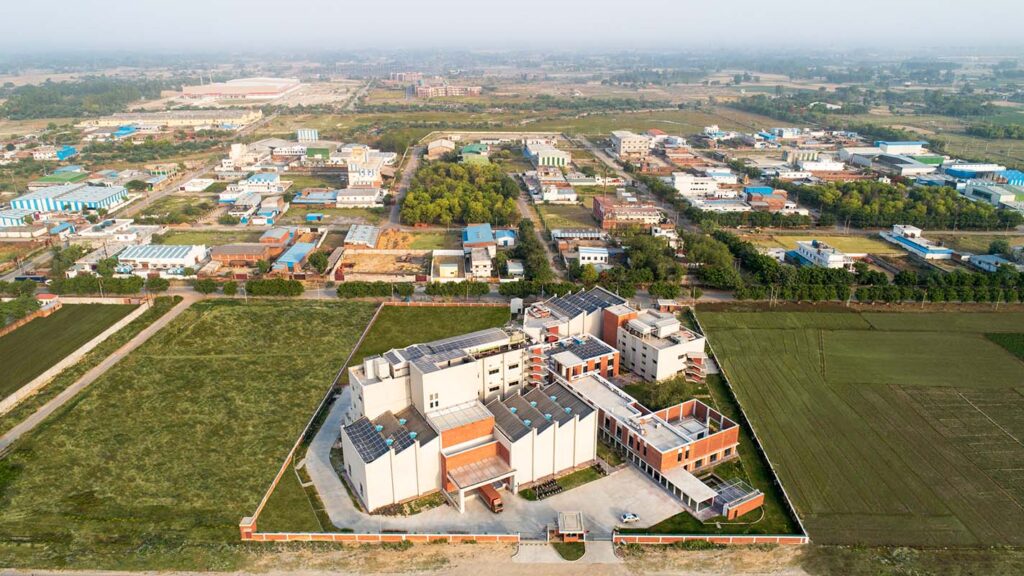
The Integrated Production Facility for Organic India in Lucknow is a sprawling campus designed to support the production, processing, and administrative functions for the holistic wellness brand. Located in Chinhat, an industrial area on the outskirts of the state capital of Uttar Pradesh, the site surroundings are characterized by low-rise developments and small manufacturing plants interspersed with small fields of barley and legumes. This upcoming industrial zone creates a verdant backdrop for the facility that has been designed to capitalize on the abundant open space to provide an atypical work environment for its factory workers and administrators alike.
Two sets of intersecting axes characterize the building footprint of the facility; the resulting interstitial spaces emerge as courtyards, lightwells, and lawns that provide space for interaction as well as relaxation to the facility staff. The built vocabulary of the facility has been articulated in brick and concrete, with sleek lines and planar symmetry characterizing the façade design.
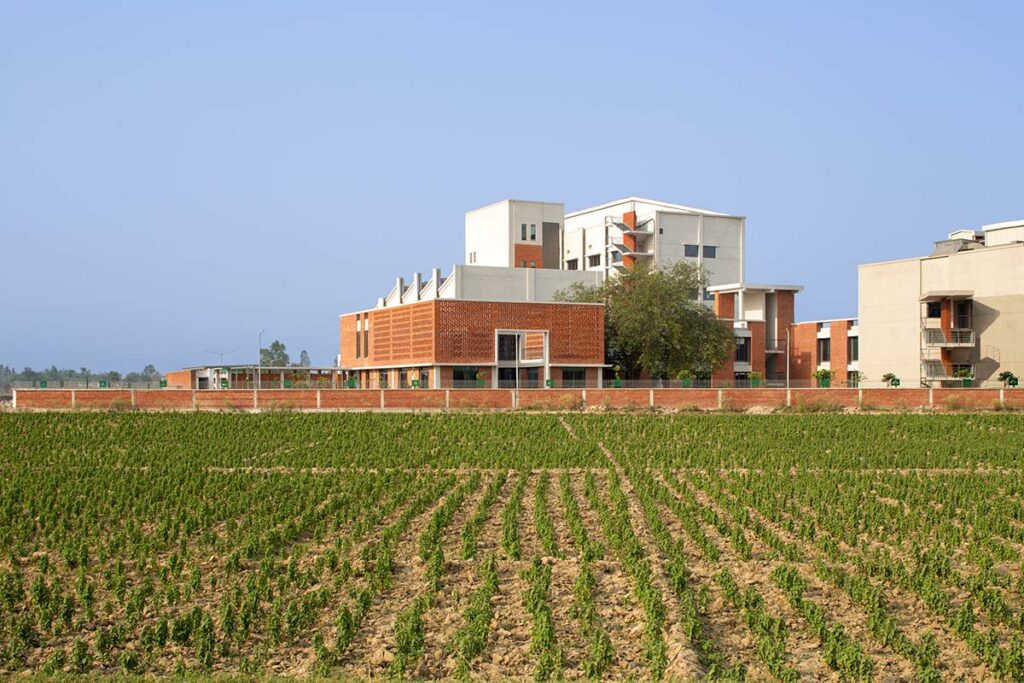

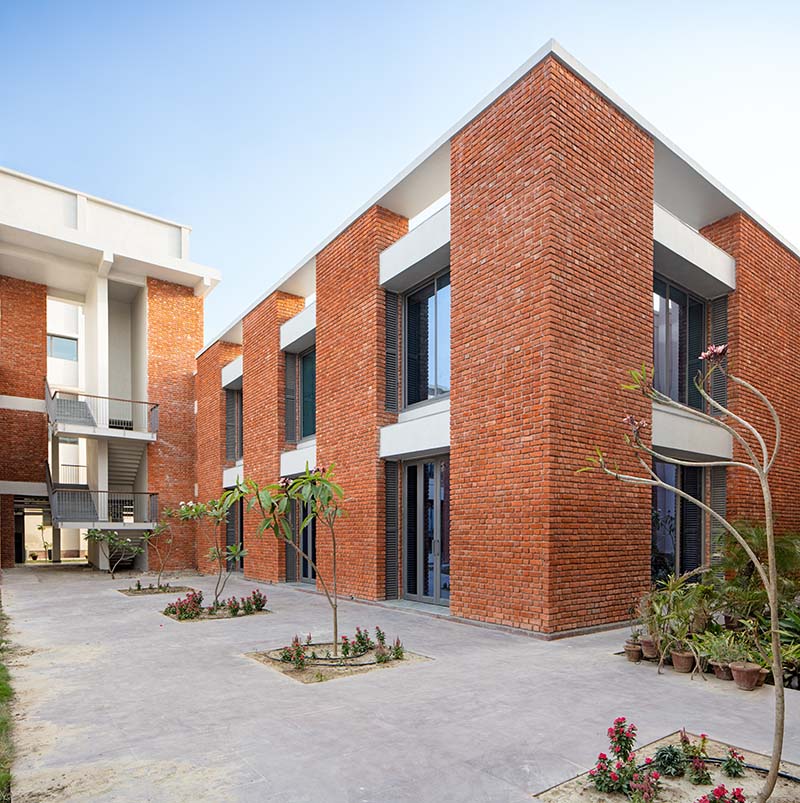

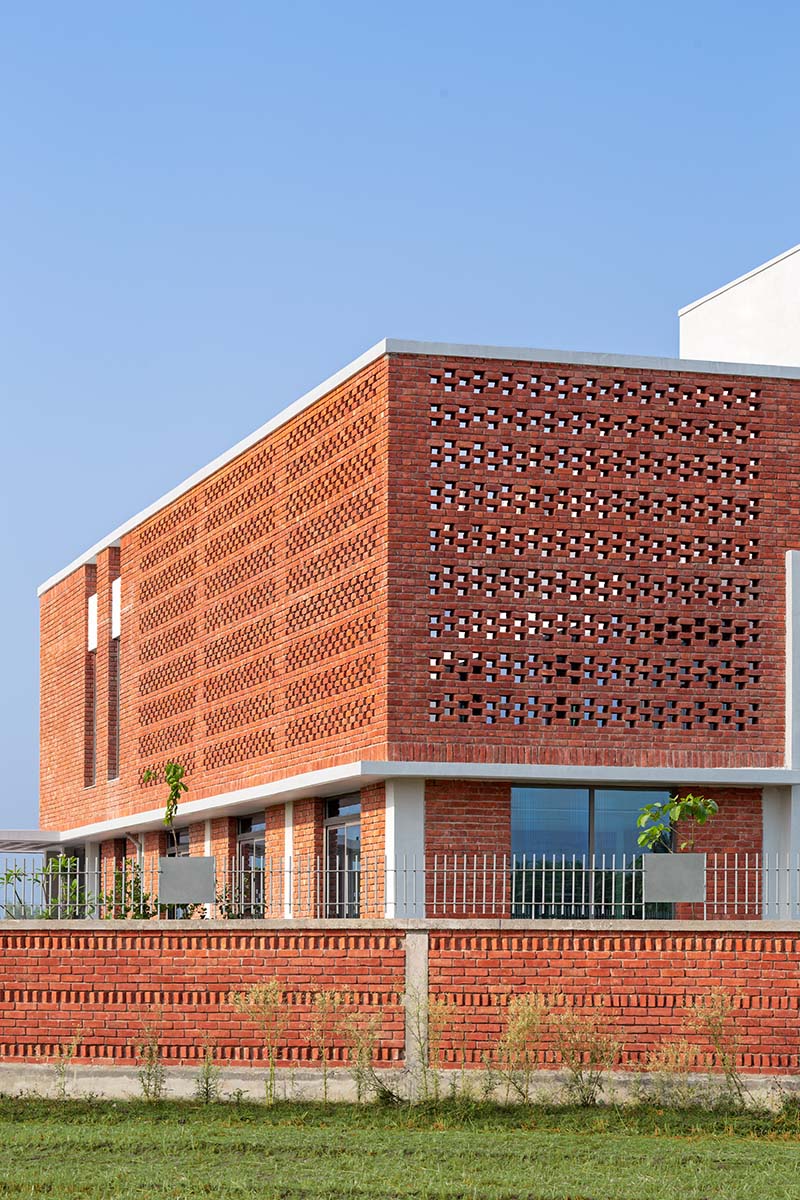

The axes conceptualized for the facility’s design have been staggered to lay at an angle to the site boundaries—the resulting footprint creating large open spaces along the periphery to accommodate staff parking, heavy vehicle manoeuvring and off-loading, and recreational zones towards the east, west, and north sides; the southern side of the site has been reserved for services, in tune with Vastu recommendations. To segregate worker and visitor traffic as well as pedestrian and vehicular access, however, the entrance for the Production Wing has been provided from the western flank.
This relatively private access provides workers the opportunity to assemble before starting work as well as clears the driveway for incoming lorries. Preceded by a large lawn, the entrance along the western flank opens into a set of decontamination chambers for the workers, which allows them to systematically execute hygiene procedures before entering the production wing and subsequently the Raw Materials section.


The Production Wing has been designed to ensure seamless transfer of raw material to individual processing units, and their subsequent movement to the packaging department. The Raw Materials section is a triple-height space, with a sophisticated pulley system installed to move goods to the top floor—from where they are moved laterally to the processing units. The processing units are housed in modular rooms that are 3m wide each, each designed to the specification for the machinery housed within. The goods are then moved through a top-down processing system, with preliminary steps like sorting and drying executed on the topmost floor, and more sophisticated secondary functions executed on the ground and first floor.
The goods, having moved down the production line, are loaded onto a conveyor belt connecting the Production Wing to the Finished Goods Block, which is located towards the Northern end of the site. Here, the processed goods are inspected, packaged and made ready for dispatch. The Finished Goods block—which is adjacent to the Quality Control Department — opens into a driveway with restricted access, allowing approved goods to be moved off-site without disturbing the functions of the rest of the facility. This movement of goods from the Eastern to Western side of the site marks the production line, forming the functional spine of the facility.
The spaces supporting the administrative functions of Organic India complement this functional spine, extending from the Finished Goods block to the drop-off for the Raw Materials section. The built vocabulary of these blocks is porous and composite, as compared to the monolithic appearance of the processing wings. To the eastern end is the Experience Centre for Organic India, a two-storey space wrapped in a tessellated brick screen; the facility’s amphitheatre and temple precedes this centre — the three, in conjunction, mark the visitors’ zone of the facility. The office spaces, expressed in a similar vocabulary, about the Experience Centre — extending towards the west in a linear configuration, and housing the Finance, HR and Sales departments. Ancillary functions for the administrative staff are located towards the end of the Administrative Block, and consist of meeting rooms, a gym, and the cafeteria.
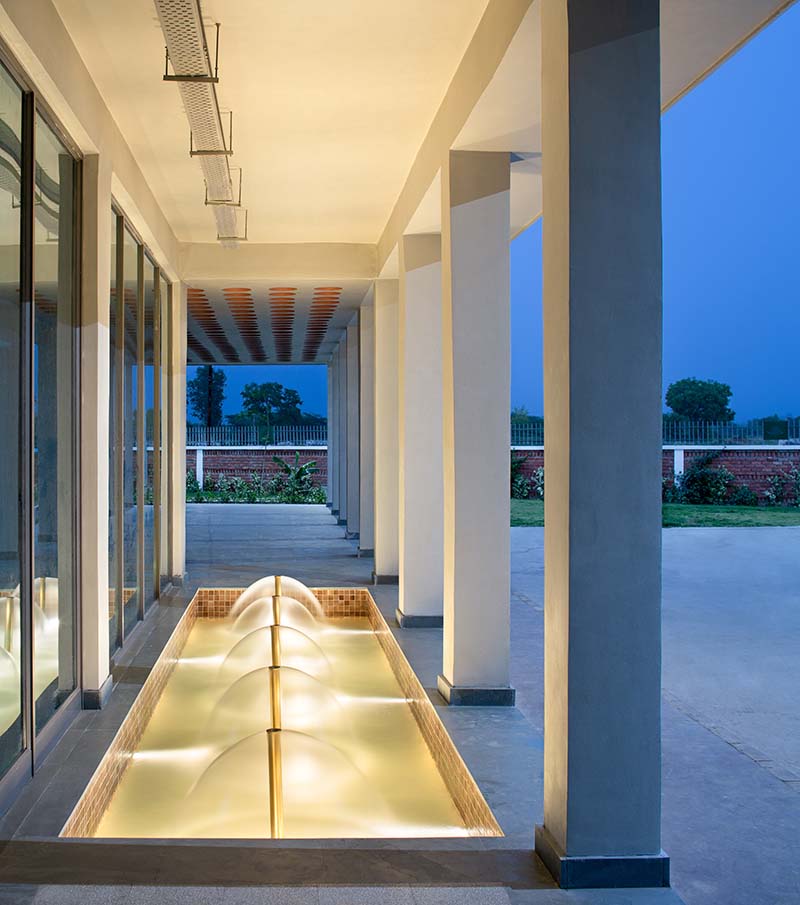

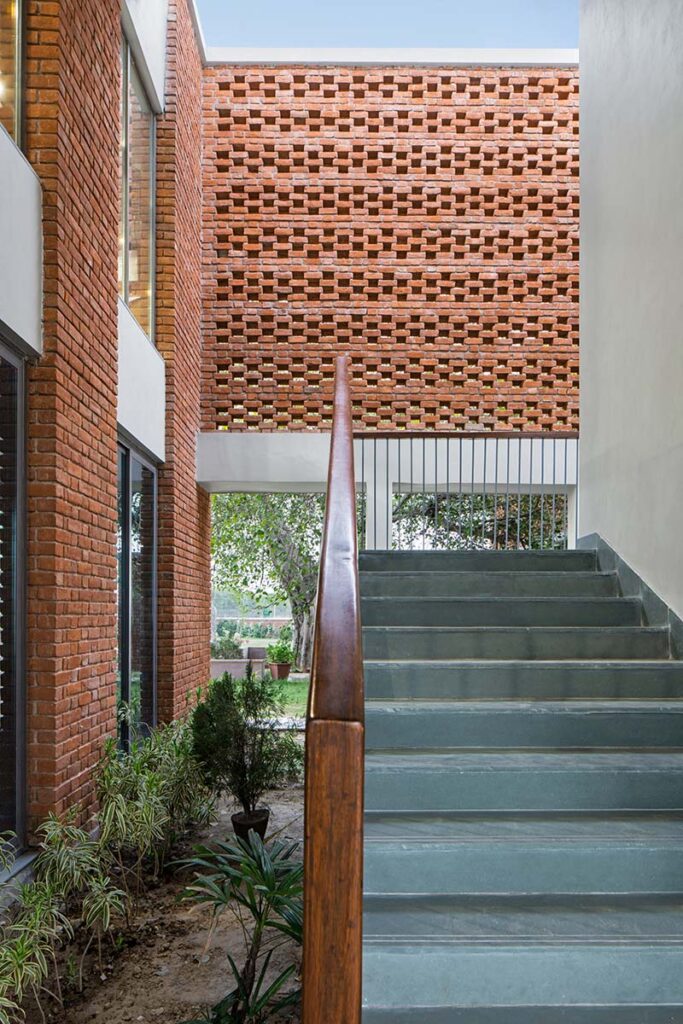
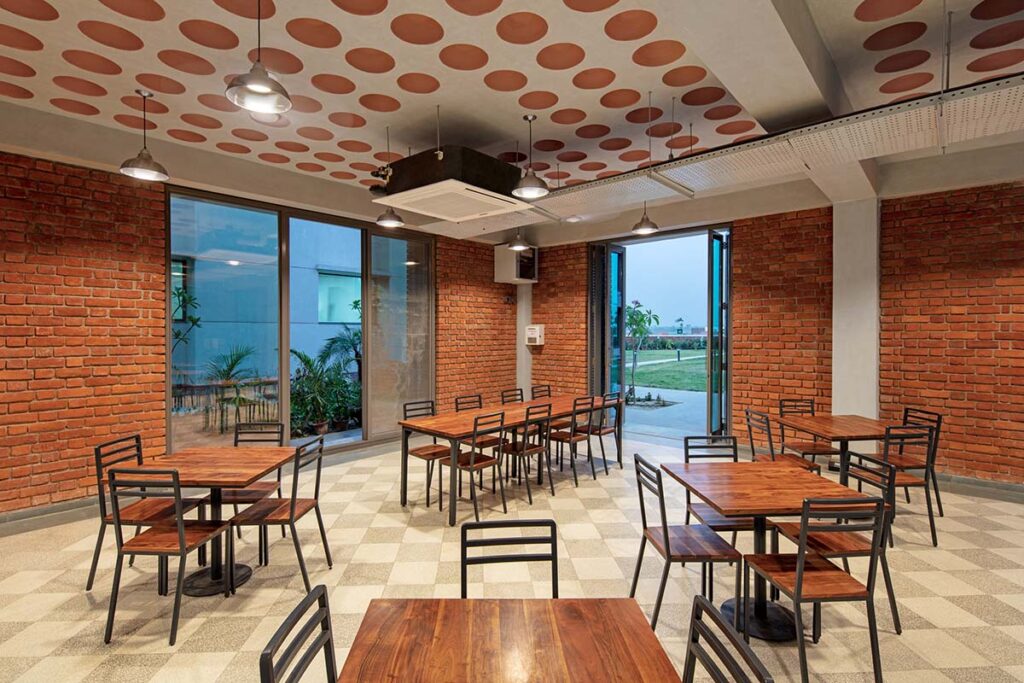

The administrative spaces of the facility wrap around a large lawn, facing north. A large tree retained on-site stands in this lawn, and has been christened the Bodhi Tree for the campus to pay homage to Organic India’s commitment to mindfulness for the self and for the community. The administrative spaces, through numerous balconies and box windows, look into this lawn; the provision of nooks and perches along the building envelope lends a meditative quality to the workspaces.
The design scheme of the facility imbibes local influences to create a sustainable built environment, the primary among these being the use of bricks as the primary infill material. Left exposed, the facility’s brick shell harkens to the regency structures of colonial Lucknow; bricks are also locally available due to abundance of labour-intensive kilns and availability of pliable clay, lowering the carbon footprint of the campus.The fenestration strategy, in tune, has been devised to provide the optimal wall-window ratio to each zone: the processing blocks have limited ingress of light, facilitated through skylights and north lights, to prevent spoilage of goods. On the other hand, high ingress of light has been enabled in the administrative blocks, to help lower dependence on artificial means of lighting.
The interstitial open spaces on campus further aid climate control in multiple ways, primarily by enabling passive cooling of the blocks through the stack effect. The abundance of open spaces and limited hardscaping also increases the potential for recharging the groundwater table. The design of the facility also ensures the channelling of surface run-off for reuse, as well as recycling of greywater discharge—the result has been the reduction of potable water consumption by more than half of the initial demand.
The design scheme utilizes, in addition, a gamut of passive cooling techniques—such as terracotta filler slabs in the large-span spaces, and recessed openings to cut out solar glare. Over one-tenth of the material used in the construction of the facility is recycled; as a result of these interventions, among many others, the project has been awarded a LEED Platinum rating.
The Integrated Production Facility for Organic India combines the production and administration sides of the wellness brand to create a campus that stands exemplar of sustainable development—not only in tangible terms of material use and energy consumption but also through the provision of a built environment that caters to the physical and psychological wellbeing of its occupants. The expansive open spaces, permeable built fabric, focus on community and introspection, and prioritization of the workers’ safety and comfort over all else has created an architectural template for all future properties for the company.
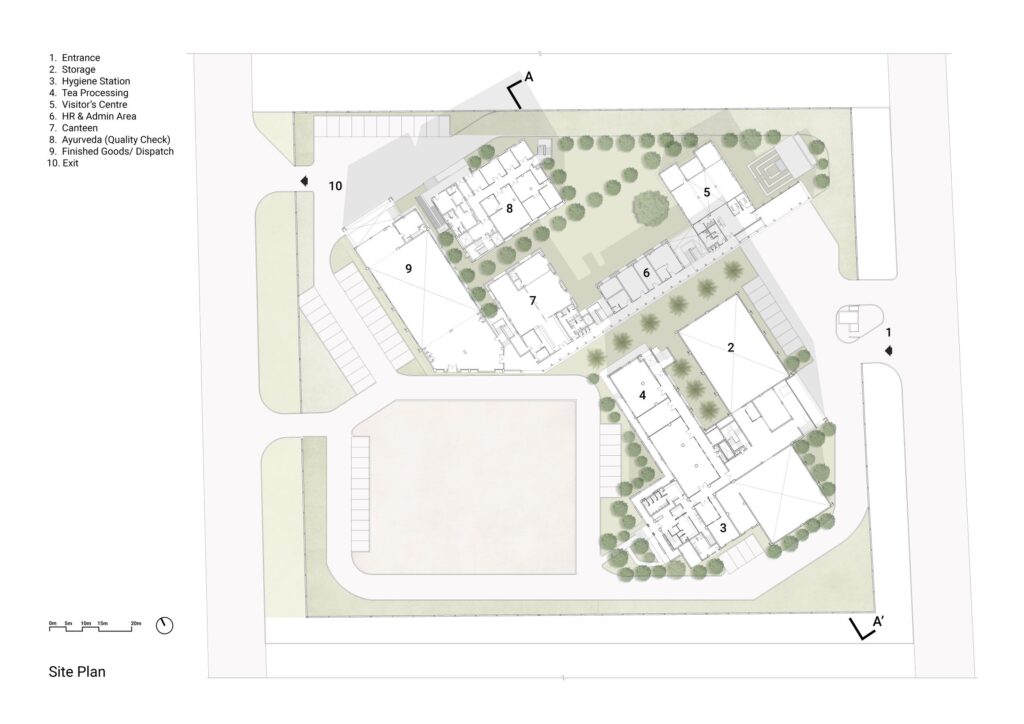


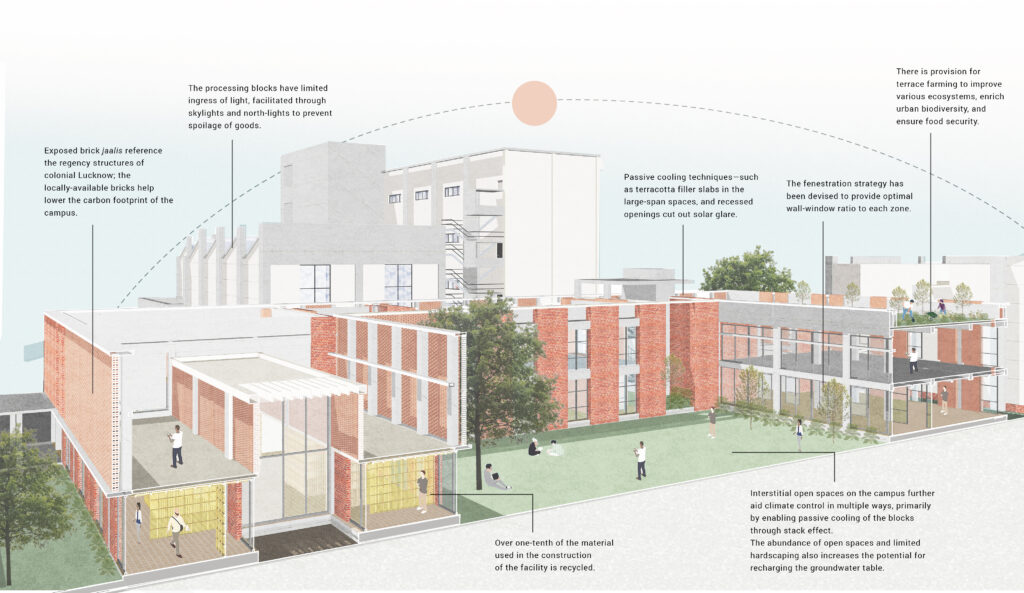
Project Details:
Name: Integrated Production Facility for Organic India
Location: Chinhat, Lucknow
Client: Bharat Mitra & Bhavani Lev (Organic India)
Status: Completed (2019)
Site Area: 4.2 acres
Built-Up Area: 1,20,000 sq. ft.
Architects: Studio Lotus—Sidhartha Talwar, Ambrish Arora, Nitika Srivastava, Raman Vig
Structural Consultants: NNC, New Delhi
Mechanical Consultants: Blue Star
Electrical Consultants: Blue Star
Civil Consultants: Dynacon India Pvt Ltd.
Landscape Consultants: Roha Landscapes
HVAC Consultants: Blue Star
Plumbing Consultants: Blue Star
PMC Consultants: ENAR Consultants
Energy Consultants: EDS GLOBAL
Photographs: André J Fanthome







One Response
Hi, Mechanical, electrical, fire, plumbing and HVAC (MEP) consultants were PARADIGM Services Mumbai not blue star. Blue star were contractors